3D Printing Opening Doors For Students & Entrepreneurs
19th February 2015
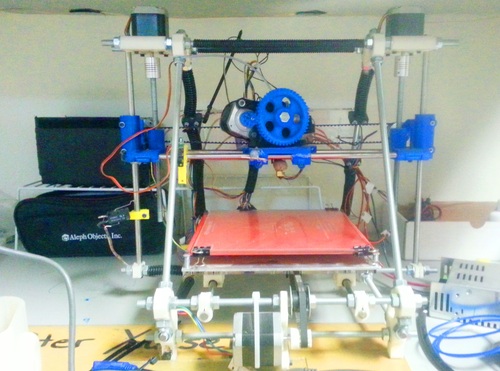
“A 3-D printer with parts 3-D printed from another printer.”
Artistic, functional, mechanical and experimental: 3D printing is demolishing barriers for a huge breadth of applications.
The technology has been around for more than 30 years, but as personal 3D printers have become more popular in recent years, entrepreneurs, experimenters, and creators from every background imaginable are using it as an option to further their ideas.
Chris Coleman, director of the Emergent Digital Practices program at the University of Denver, says that expanding the bodies of knowledge about 3D printing is one of the first steps to helping the industry grow.
“What we’re trying to do is put more young people into the field, who can operate 3D printers, make decisions about what it means to output things on a 3D printer, understand it as a medium,” Coleman says. “The biggest part of running a 3D printer in-house is having someone who understands how it works, and how to maintain it.”
The applications for 3D printing are growing, in large part due to the huge range of materials that can be used to 3D print items, including all kinds of metals, ceramics, plastics, paper and wood.
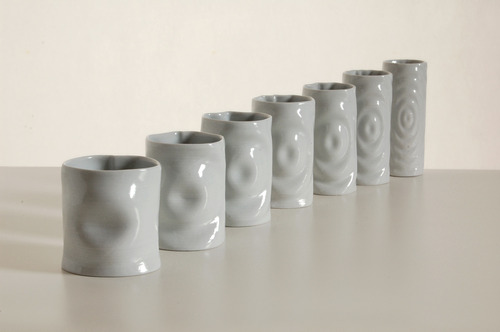
“Artist Jonathan Keep’s 3-D printed ceramic art, "Sine Wave Morphology - Drop”. Photo courtesy Jonathan Keep.“
The University of Denver’s EDP program presents 3D printing in a few different forms, Coleman says. A new class, being held for the first time during this spring 2015 semester, shows students how to use a 3D printer, from the initial computer modeling, fine-tuning designs to the final printing process. Other classes, such as the tangible interaction class taught by Coleman, challenge students to design more complex items, such as ones with gears, joints or other moveable parts. For more advanced classes, students have access to 3D printers to help them quickly create parts they might need as a small piece of a larger overall project.
“Some students are experimenting with basic robotics,” Coleman says. “For example, they could 3D print an armature that allows the robot to move around the room in a new or interesting way.”
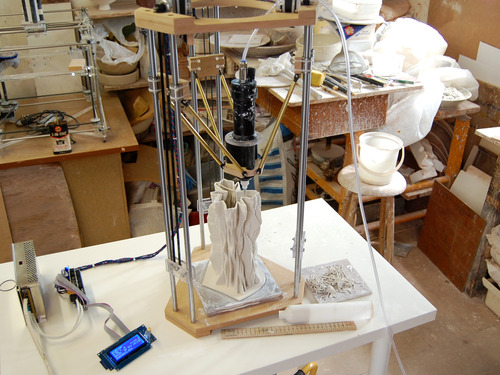
"Artist Jonathan Keep uses a self-built 3-D printer to print a ceramic item. Photo courtesy Jonathan Keep.”
Many students in the EDP program overlap with the university’s engineering programs, but most recently, a creative, artistic application was adopted.
Coleman says that the program had Jonathan Keep, an artist who uses 3D printing as a medium, flown in from the United Kingdom in February to help build and tune two printers that use ceramic as the printing material. These printers may offer another option for DU’s art programs.
“We have a collaborative class with the sculpture department, they have digital sculpting class,” Coleman says. “The outputs of that class are 3D prints.”
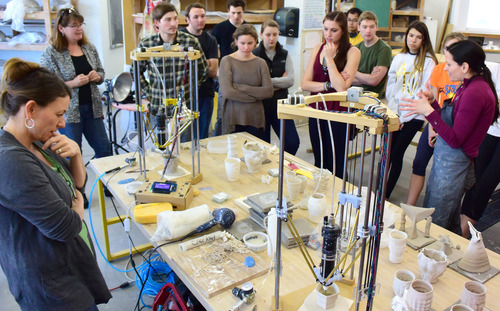
Photo by Timothy Weaver
Keep’s and DU’s experiences with 3D printing as an art form are examples of how the technology, often using open-source plans, can be adapted for unusual applications. As businesses and organizations in Colorado search for their own new and interesting ways to draw the ever-wandering eye of digital consumers, 3D printing is finding its way into places such as libraries.
The Denver Public Library prints items for free on its two 3D printers. Library 21c in Colorado Springs charges people to print items, but at five cents per gram of filament used, many people are charged less than a dollar, says Becca Cruz, creative computer commons manager at Library 21c. Cruz says people who are interested in 3D printing vary greatly.
“We get lots of different kinds of people, a wide variety of ages,” she says. “If you have something like an antique radio, and you can’t buy a new knob for it, you can come in and 3D print one and paint it to match, and have your radio up and functioning again.”
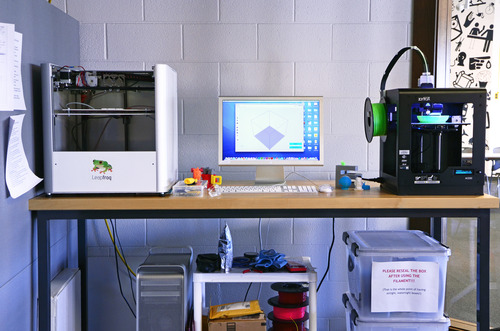
Photo by Jenny Filipetti
Library 21c also offers classes for the community to learn how to 3D print, and has a public computer with a CAD program on it – that’s Computer-Aided Design – “for people who know what they’re doing,” Cruz says. And those services are free.
“We ask that people have a library card, but if you live in Colorado you can get a library card really easily,” Cruz says. “We just charge for the filament that’s used. It’s pretty nominal fee.”
Once a 3D printer is established, the only cost to use one is for the printing material, which can be as low as $25 for a spool of plastic filament. DU’s educational initiatives and the local community’s support for this technology promises opportunity for Colorado’s entrepreneurial future.
by April Nowicki
1 Notes
 distrakt liked this
distrakt liked this innovatorspeak posted this
innovatorspeak posted this
